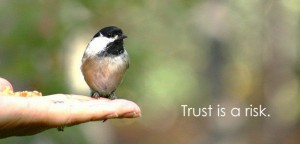 Last week, my business partner Moss Jackson and I finished up a leadership development program that we had created for a long-time client. The program brought together senior leaders from different business units and corporate functions within the company, who worked in small teams on a variety of challenges. All but one of the challenges was short-fused, and required the team members to quickly formulate an approach to the problem, adopt appropriate roles, then execute smoothly to complete the assigned tasks. We added an immediate feedback loop, wherein the teams were scored by a set of judges on how well they completed each of the assigned challenges and presented their results. During the course of the program we mixed up the teams, so that each individual program participant worked with every other participant at least once. We also added an element of personal competition to the program, with each participant’s score being the total of the points earned on each of his or her team assignments.
Last week, my business partner Moss Jackson and I finished up a leadership development program that we had created for a long-time client. The program brought together senior leaders from different business units and corporate functions within the company, who worked in small teams on a variety of challenges. All but one of the challenges was short-fused, and required the team members to quickly formulate an approach to the problem, adopt appropriate roles, then execute smoothly to complete the assigned tasks. We added an immediate feedback loop, wherein the teams were scored by a set of judges on how well they completed each of the assigned challenges and presented their results. During the course of the program we mixed up the teams, so that each individual program participant worked with every other participant at least once. We also added an element of personal competition to the program, with each participant’s score being the total of the points earned on each of his or her team assignments.
 During the final debrief, several participants commented on how well they had been able to work on the team challenges with individuals from other parts of the business with whom they otherwise rarely interacted. Members of the company’s Executive Committee, who served as judges for the program’s final business challenge, noted that they were both pleased and a bit surprised at the quality of the work product delivered, considering that the challenge had been assigned less than a day earlier. As the discussion continued, I was particularly encouraged that the question the group asked itself was not the negative formulation, “Why don’t we behave like this and perform like this all of the time?” but rather the learning-based inquiries: “What happened here?; How did we behave?; How can we act as role models for our own work teams so that we improve our level of team performance?
During the final debrief, several participants commented on how well they had been able to work on the team challenges with individuals from other parts of the business with whom they otherwise rarely interacted. Members of the company’s Executive Committee, who served as judges for the program’s final business challenge, noted that they were both pleased and a bit surprised at the quality of the work product delivered, considering that the challenge had been assigned less than a day earlier. As the discussion continued, I was particularly encouraged that the question the group asked itself was not the negative formulation, “Why don’t we behave like this and perform like this all of the time?” but rather the learning-based inquiries: “What happened here?; How did we behave?; How can we act as role models for our own work teams so that we improve our level of team performance?
We identified four significant factors at work that led to the extremely strong performance of these ad hoc teams, which we converted into rules for quickly building high-performing teams.
 Rule 1: Trust others first. The fastest way to build trust is to show that you trust the other members of the team. While it may be difficult to offer up your own vulnerability, in most situations it works a whole lot better than asking, “Trust me.” Our program participants emphasized the critical importance of trust building to their ability to work together on team projects. What really hit me was how often they said that they now felt that they had strong connections with people throughout the organization; people they could go to for help at any time, and on any issue where they needed help.
Rule 1: Trust others first. The fastest way to build trust is to show that you trust the other members of the team. While it may be difficult to offer up your own vulnerability, in most situations it works a whole lot better than asking, “Trust me.” Our program participants emphasized the critical importance of trust building to their ability to work together on team projects. What really hit me was how often they said that they now felt that they had strong connections with people throughout the organization; people they could go to for help at any time, and on any issue where they needed help.
 Rule 2: Defer judgment. Getting quick results required the teams to generate a large number of possibilities in a short period of time. They seemed to understand that nothing will slow down anyone’s problem-solving work in a team environment faster than getting their ideas shot down, so they withheld judgment until lots of ideas were on the table. Even after the teams had generated many ideas, their analytic approach allowed them to gravitate toward solutions with the greatest likelihood of success. Further, because they built on each other’s ideas rather than promoting a personal agenda, they all felt invested in and committed to the solution path they chose.
Rule 2: Defer judgment. Getting quick results required the teams to generate a large number of possibilities in a short period of time. They seemed to understand that nothing will slow down anyone’s problem-solving work in a team environment faster than getting their ideas shot down, so they withheld judgment until lots of ideas were on the table. Even after the teams had generated many ideas, their analytic approach allowed them to gravitate toward solutions with the greatest likelihood of success. Further, because they built on each other’s ideas rather than promoting a personal agenda, they all felt invested in and committed to the solution path they chose.
 Rule 3. Build and share a common language. This one was the trickiest to implement, but turned out to be extremely powerful. The language was less a technical jargon than a language of purpose and vision that the company had created a year earlier during a senior leadership retreat to re-examine its mission and vision. The process used to develop the specific phrasing of the company mission, vision and values statements and roll them out to the entire organization was thoughtful and inclusive, so that language became part of the everyday work context of the organization. All of the program participants, regardless of business unit or functional affiliation, were connected by the common language of mission, vison and values, enabling them to quickly forge a team identity around each of the challenges presented to them.
Rule 3. Build and share a common language. This one was the trickiest to implement, but turned out to be extremely powerful. The language was less a technical jargon than a language of purpose and vision that the company had created a year earlier during a senior leadership retreat to re-examine its mission and vision. The process used to develop the specific phrasing of the company mission, vision and values statements and roll them out to the entire organization was thoughtful and inclusive, so that language became part of the everyday work context of the organization. All of the program participants, regardless of business unit or functional affiliation, were connected by the common language of mission, vison and values, enabling them to quickly forge a team identity around each of the challenges presented to them.
 Rule 4. Create a sense of urgency. Nothing creates task focus better than a hard deadline. When the clock is ticking down against a deadline, everyone’s attention is sharpened. The rush of adrenaline makes it easier to block out distractions. No one wants to stand around idly, so each team member searches for aways to use her skills and abilities to complement the skills and abilities brought to the task by other team members.
Rule 4. Create a sense of urgency. Nothing creates task focus better than a hard deadline. When the clock is ticking down against a deadline, everyone’s attention is sharpened. The rush of adrenaline makes it easier to block out distractions. No one wants to stand around idly, so each team member searches for aways to use her skills and abilities to complement the skills and abilities brought to the task by other team members.
These rules may not be universal, but they certainly worked well in this lab-like environment, and are likely to prove successful when implemented more broadly throughout the organization.
What other rules would you suggest to people interested in quickly building high-performing teams?
Dave,
It was a pleasure being a part of the team and have learnt many skills including critical thinking, collaboration and building trust that will help me in the future
Rajeev, I took away a a lot more than I brought with me to the program. Thanks for helping me learn more about how great teams form.
It was great working with you again, our third time!!
I think the core base with this group was while we might have not worked closely with each ohter often in the past, we did do some work and we all had a mutual respect from the onset. We also liked each other!! These two factors lead to almost an immediate trust which in turn lead to a great program.
For me as others, “Critical Thiniking” was the take away and for me the most important skill learning that I can focus on.
Thanks for the great work and on the side, not only people with children like Legos. I love them!!
D
David,
I hope we can share more opportunities to learn and grow in the future.
Dave,
I really liked this post, including the touching picture of the little bird, even though I was not part of the process. It is the kind of thing I did many years ago with my journalism team at Uni H. S.
The rewards from these team experiences went way beyond the classroom (and the deadline was always publication; we often worked on weekends). The human connections were powerful and long-lasting. I still hear from some of those students and their parents.
Very nice work.